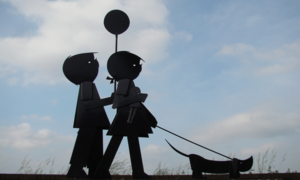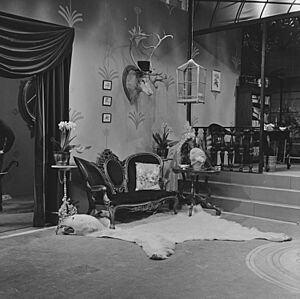Annie M.G. Schmidt facts for kids
Quick facts for kids
Annie M.G. Schmidt
|
|
|---|---|

Schmidt in 1984
|
|
| Born | Anna Maria Geertruida Schmidt 20 May 1911 Kapelle, Netherlands |
| Died | 21 May 1995 (aged 84) Amsterdam, Netherlands |
| Resting place | Zorgvliet, Amstelveen, Netherlands |
| Occupation | Writer, librarian |
| Language | Dutch |
| Nationality | Dutch |
| Education | librarian |
| Period | 1947–1989 |
| Genre | Children's literature, poetry, lyrics, comedy/drama, radio/television |
| Notable works |
|
| Notable awards | Hans Christian Andersen Award for Writing 1988 |
| Partner | Dick van Duijn (1950–1981) |
| Children | Flip van Duijn (born 1952) |
| Signature | |
 |
|
Anna Maria Geertruida "Annie" Schmidt (born May 20, 1911 – died May 21, 1995) was a famous Dutch writer. Many people call her the "mother of Dutch theatrical songs" and the "queen of Dutch children's literature." She was loved for her wonderful way with words and is seen as one of the greatest Dutch writers ever.
After she passed away, she received a special honor in 2007. A group of Dutch historians created the "Canon of the Netherlands," which is a list of important people and events in Dutch history. Annie M.G. Schmidt was included alongside famous figures like Vincent van Gogh and Anne Frank.
Even though Schmidt wrote poetry, songs, books, plays, musicals, and radio and television shows for adults, she is best known for her children's books. Her most famous work for kids is probably the series Jip and Janneke. Many of her books, like Pluk van de Petteflet, were brought to life with illustrations by Fiep Westendorp.
In 1988, Schmidt won the Hans Christian Andersen Medal for her amazing work as a children's writer. This award is given every two years by the International Board on Books for Young People. It is the highest honor a writer or illustrator of children's books can receive.
By the time she died in 1995, she was a true legend in the Dutch writing world.
Contents
Early Life
Anna Maria Geertruida "Annie" Schmidt was born on May 20, 1911, in Kapelle, a town in Zeeland, Netherlands. Her father, Johannes Daniel Schmidt, was a minister, and her mother, Geertruida Maria Bouhuijs, was a school teacher. She had an older brother named Wim. She also had two older sisters, both named Anna M.G., who sadly died young before she was born. Her family called her Zus, which means "Sister" in English.
Annie was a quiet child who wore thick glasses. She found comfort and fun in writing poetry and stories. Even though she once got a very low grade (a 2 out of 10) in her Dutch class, she later joked about it! Her mother encouraged her writing and even sent some of her poems to a famous poet named Willem Kloos.
After finishing high school in Goes and working as a helper in Germany, she decided to study to become a librarian. She worked as a librarian until 1946.
Career Highlights
In 1947, Annie Schmidt started her writing career. She began by writing for an Amsterdam newspaper called Het Parool. Soon after, she started writing songs and short plays for performers like Wim Sonneveld and Wim Kan.
Her writing career really took off in the early 1950s. She wrote songs and plays for the theater, scripts for radio and television shows, columns for newspapers, and, of course, many children's books.
In 1964, she won an important literary award called the Staatsprijs voor kinder- en jeugdliteratuur, which is a state prize for children's and youth literature.
Her last book, Wat Ik Nog Weet (which means "What I Still Remember"), was a collection of her childhood memories. It came out in 1992. She passed away just one day after her 84th birthday and was buried in Amsterdam.
Annie M.G. Schmidt was a huge inspiration in the Dutch literary world. Her life has been the subject of plays, and her books are still printed and loved today. Her plays are also still performed.
She is one of the important topics in the Canon of the Netherlands. This Canon is a list of fifty key topics in Dutch history. It was created to help teach Dutch history in primary and early secondary schools. Annie M.G. Schmidt is still included as one of these important figures.
Famous Books
Jip en Janneke

Schmidt started writing Jip en Janneke when she was working at the Het Parool newspaper in Amsterdam. Jip and Janneke are two children who live next door to each other. Every week, they had short, fun adventures. Some of these stories were even based on real adventures involving Schmidt's own son, Flip, and the girl who lived next door to them. The stories were beautifully illustrated by Fiep Westendorp.
The first Jip en Janneke story was published on September 13, 1952, and the last on September 7, 1957. A total of eight book collections were published between 1953 and 1960. Jip and Janneke are among the most famous children's characters in the Netherlands. They are so well-known that their pictures are used on many products sold by the HEMA department stores.
Minoes or Undercover Kitty / Miss Minoes
Minoes (published in 1970) tells the story of a cat who magically turns into a young lady. She helps a young journalist keep his job at the newspaper by sharing all the gossip she hears from the cat world.
In 2001, a movie based on Minoes was made, called Undercover Kitty. It was directed by Vincent Bal. This film became one of the most popular Dutch children's movies shown in other countries. Minoes won two Golden Calves, which are important Dutch film awards. It was the best-selling Dutch children's film at the time, and its DVD sold so well that it was certified platinum in 2002. More than 815,000 people watched the movie in theaters, making it the highest-selling Dutch film of that year. The film also won first prize at the 2002 Chicago International Children's Film Festival. The book Minoes has been translated into English with titles like Minnie (1992) and The Cat Who Came In off the Roof (2014).
Radio and Television Shows
In 1952, Schmidt started writing a radio show called De Familie Doorsnee, which ran until 1958. In 1957, she began writing Pension Hommeles, a musical comedy for VARA television.
Ja Zuster, Nee Zuster or Yes Nurse! No Nurse!
In the 1960s, Annie Schmidt wrote one of the most popular Dutch television series ever, Ja zuster, nee zuster (which means Yes Nurse! No Nurse!). This show later inspired a movie in 2002 with the same name.
Some people believe that the story of Tante Patent, a comic strip Annie M.G. wrote in 1962, was an early idea for Ja Zuster, Nee Zuster.
See Also
 In Spanish: Anna Maria Geertruida Schmidt para niños
In Spanish: Anna Maria Geertruida Schmidt para niños




